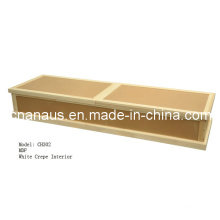Garden ground cover conservation management
2021-06-06
Ground cover plants are an important part of the urban green space. They have changed from the evergreen type to diversification, and they have turned from pure grass to flower patterns. Since the characteristics of the ground cover plants are large-scale cultivation of a large area, under normal circumstances, it is generally not allowed to do fine maintenance, but can only be based on extensive management. According to the actual situation in China and the experience of some cities, the main points for the management of ground cover management are as follows: 1. Prevent soil and water loss The soil of the planting site must be kept loose and fertile. Drainage must be better. In general, it should be checked once or twice a year. After a heavy rain, check carefully to see if there is any erosion damage. In regions with serious soil erosion, measures should be taken immediately to plug the loopholes, otherwise the loss will continue to expand, creating a situation that is difficult to clean up. Second, increase the soil fertility in the plant growth period, should be based on the needs of various types of plants, timely replenishment of fertility, especially for some flower ground cover plants more important. The commonly used fertilization methods include spray method, which is simple, suitable for large areas, and can be applied during the growing period of plants to increase the application of thin ammonium sulfate, urea, calcium phosphate, potassium chloride and other inorganic fertilizers. Sometimes in early spring and late autumn or before and after the dormant period of the plant, application methods, combined with earth covering, are beneficial to the wintering of the plants, and they can be adapted to local conditions and make full use of compost, cake, river mud and other sources of organic fertilizer. 3. Drought-resistant watered ground cover plants Under normal circumstances, drought-resistant varieties with strong adaptability are selected and watering is not required. However, when there is continuous drought and no rain, watering should be carried out in order to prevent ground cover plants from severe drought. IV. Pest Control Most of the ground cover plant species have strong resistance to pests and diseases, but sometimes due to poor drainage or improper fertilization and other reasons, it can also cause pests and diseases. Planting plants on a large area is the most likely cause of blight, which can make a lot of land withered. It should be controlled by spraying measures to prevent its spread. Followed by gray mold, coal pollution, should also pay attention to prevention and treatment. Insect pests are most likely to occur as aphids, bridges, etc., and should be sprayed after the occurrence of pests. Due to the large planting area of ground cover, prevention and control methods should be based on prevention. Fifth, the prevention and treatment of empty bald In the ground cultivation of large areas, most afraid of baldness, especially after the formation of empty bald, very unsightly. therefore. Once there, immediately check the cause and loosen the soil. If the soil quality is poor, the soil should be changed and supplemented to restore the landscape. Sixth, pruning the general low-type species does not require regular pruning, mainly to extensive management. However, in recent years, a large number of flower-covered ground cover plants have been introduced throughout the country, and a few with high-risk flowers or flower-stem heights must be properly reduced after flowering, or combined with seed harvesting and proper pruning. VII. Renewal Recovery In the management of ground cover plants, due to a variety of unfavorable factors, premature senescence has been observed. According to different conditions, the topsoil should be punctured so that the roots can be loose and air-permeable. At the same time, the application of fertilizers and watering can be enhanced, which is conducive to rejuvenation. For perennial habitats of some flower-seeking species, they must be planted once every five or six years. Otherwise, they will cause natural decline. When the ramets are planted, aging plants and diseased plants should be removed, and those who are healthy should be replanted. VIII. The adjustment of the ground cover is longer than that of other plants, but not once after planting. In addition to some varieties have their own ability to update, generally need to consider from the viewing effect, coverage and other aspects, if necessary, make appropriate adjustments. Pay attention to the coordination of colors, it should be eye-catching. Avoid weeds. For example, in the green lawn, suitable for planting some flower gardens, the colors are easy to coordinate, such as the low purple viola, the white trifoliate white flower, and the yellow flower dandelion. Another example is the snow-white snowballs and sunflowers planted on the edge of a road or lawn, which are more elegant, eye-catching and luxurious.
We professional produce Ground Cover,Ground Cover Cloth,Weed Mat,factory have 10 produce line,can supply different width 0.5-5m,50m,100m length or as client`s require.Weed Control Fabric material is 100% virgin PP with UV protection,high quality and long use time.
Woven Weed Control Fabric can prevent weeds growth,control soil humidity and temperature,against the insect,conducive to plant root growth and prevent root rot and prevent bonsai root growth outward,improve flower quality.
Our Weed Control Mesh export to UK,France,Ireland,American,Canada,Chile,Panama,Kuwait etc countries.
Woven Weed Control Fabric, Green Weed Mat, Weed Barrier Mat, Fruit Mat
Zhejiang Xinglong Packing Co., Ltd http://www.penettings.com









